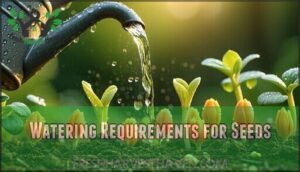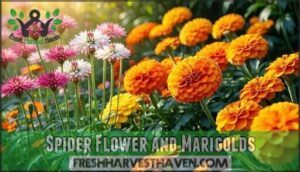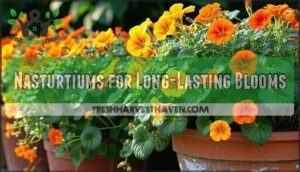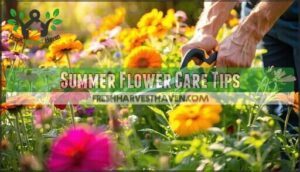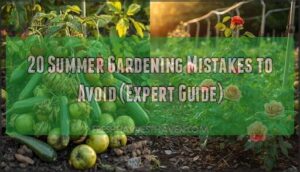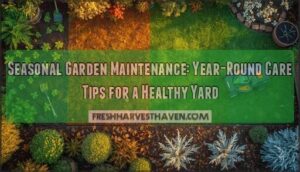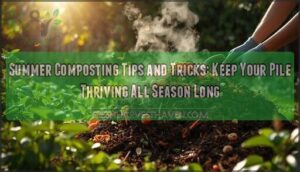This site is supported by our readers. We may earn a commission, at no cost to you, if you purchase through links.
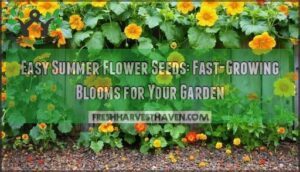
These hardy annuals forgive beginner mistakes and grow fast – some sprouting in just days. Simply scatter seeds in well-draining soil after the last frost, water gently, and watch magic happen.
Sunflowers reach for the sky while nasturtiums cascade beautifully. Zinnias and marigolds create stunning borders, and cosmos add delicate charm.
These flowers practically grow themselves, making gardening feel less like work and more like play. The secret lies in timing and proper soil preparation.
Table Of Contents
- Key Takeaways
- Easy Summer Flower Options
- Choosing Right Seeds
- Sowing Seeds Successfully
- Fast Growing Flower Seeds
- Summer Flower Care Tips
- Frequently Asked Questions (FAQs)
- What summer flowers are easy to grow from seed?
- What is the quickest flower to grow from seed?
- What is the best flower that blooms all summer?
- Can I just throw wildflower seeds on the ground?
- What is the easiest summer flower to grow?
- What is the easiest flower to start from seed?
- What is the best seed to plant in summer?
- What are the easiest flower seeds to grow?
- Can I just throw wildflower seeds around?
- What are the easiest annual flowers to grow from seed?
- Conclusion
Key Takeaways
- You’ll get quick results – Nasturtiums, sunflowers, zinnias, marigolds, and cosmos germinate within days and bloom in just 6-10 weeks from seed
- They’re beginner-friendly – These hardy annuals forgive mistakes and thrive in poor soil conditions, making them perfect if you’re new to gardening
- Timing matters most – Wait until the soil reaches 60°F and nighttime temps stay above 50°F, then simply scatter seeds and water gently
- Proper care extends blooms – Deadhead spent flowers regularly and provide 6+ hours of daily sunlight to keep your garden colorful all summer long
Easy Summer Flower Options
You’ll find success with these five easy summer flower seeds that transform your garden quickly.
Nasturtiums, sunflowers, zinnias, marigolds, and cosmos all germinate fast and produce stunning blooms within weeks of planting.
Nasturtium Seeds
Nasturtium’s vibrant blooms make these beginner flower seeds perfect for summer gardens.
These fast growing flowers establish quickly, providing edible uses beyond decoration.
Their peppery leaves and colorful petals add zest to salads while serving as natural pest repellent against aphids and cucumber beetles.
Nasturtiums thrive effortlessly, adding bold reds, oranges, and yellows to your garden while repelling pests and spicing up salads.
Quick-growing cosmos bring effortless summer color that thrives in heat and drought.
These easy summer flowers excel at:
- Companion planting—protecting tomatoes and cucumbers from harmful insects naturally
- Flavor profiles—offering peppery, watercress-like taste in both leaves and flowers
- Growth habits—thriving in poor soil where other summer flower seeds struggle
Their trailing nature makes nasturtiums ideal for containers or ground cover applications.
Sunflower Seeds
Growing sunflowers from summer flower seeds brings instant garden magic.
These fast growing flowers are perfect beginner flower seeds that germinate quickly in warm soil.
Sunflower varieties range from dwarf to towering giants, making excellent companion planting partners.
They naturally provide pest control by attracting beneficial insects.
Seed germination happens within days, and harvesting seeds later rewards you with nutritious snacks for yourself and visiting birds.
Zinnia Seeds
While sunflowers reach for the sky, zinnias keep their colorful feet firmly planted in summer soil.
These heat tolerant champions offer endless Zinnia varieties that bloom from June until frost hits. Zinnia propagation couldn’t be simpler—just scatter seeds after your last frost date and watch magic happen.
Zinnia benefits include:
- Thriving in hot, drought resistant conditions
- Resisting most Zinnia diseases with proper spacing
- Creating stunning Zinnia companions with other summer flowers
- Producing easy summer flower seeds for next season
Your Zinnia garden will reward minimal effort with maximum color payoff.
Marigold Seeds
Marigold varieties like French and African types make excellent summer flower seeds for beginners. These hardy blooms excel in companion planting, naturally repelling aphids and nematodes from your vegetables.
Edible marigolds add peppery flavor to salads, while their vibrant colors shine in container gardening. Perfect pest repellent flowers that thrive with minimal fuss.
They also act as natural pest deterrents, making them an excellent addition to any garden.
Here’s why marigolds rock your flower gardening game:
- Germinate quickly in warm soil within 5-7 days
- Bloom continuously from summer through first frost
- Self-seed readily for next year’s garden surprise
Cosmos Seeds
Cosmos varieties bring delicate, daisy-like flowers to your garden with impressive drought tolerance.
These easy to grow plants offer vibrant bloom colors in pink, white, and orange.
Seed germination happens swiftly when you direct sow after frost danger passes.
Their germination speed and self-seeding nature make cosmos perfect summer flower seeds for effortless flower gardening success.
Choosing Right Seeds
Selecting the right seeds means matching your garden’s specific conditions with each flower’s needs.
You’ll want to check your USDA zone, consider available sunlight, and evaluate your soil type before choosing varieties that’ll thrive in your space.
Understanding USDA Zones
Your success depends on knowing your USDA growing zones before buying easy summer flower seeds.
These zones, numbered 1-13, tell you which annuals and perennials survive your winters.
Zone hardiness isn’t everything though—microclimates in your yard create pockets that differ from regional variations.
Understanding plant hardiness guidelines is vital for healthy growth.
Here’s what matters for seed starting:
- First frost dates determine when you can safely sow tender flowers outdoors
- Zone changes from climate shifts mean checking updated maps regularly
- Microclimates explained simply: south-facing walls stay warmer, low spots get colder
Selecting Color Varieties
You’re creating more than just a colorful summer garden—you’re crafting an experience.
Color psychology plays a huge role in garden aesthetics.
Bright yellows and oranges energize spaces, while soft pinks and whites create calm retreats.
For vibrant summer colors, consider regional preferences and unique cultivars that thrive in your area.
Nasturtiums are also prized for their ornamental and culinary value.
Consider bloom seasonality when planning your garden palette—mixing early and late bloomers guarantees continuous color throughout summer.
This approach ensures a vibrant and inviting garden atmosphere, making the most of your regional preferences and unique cultivars.
Considering Sun Exposure
Your garden’s sun exposure determines which flower seeds will thrive. Full sun needs at least six hours of direct sunlight daily, while partial shade options work with morning sun and afternoon protection.
Consider these sun exposure factors:
- Morning sun – Gentle light perfect for heat-sensitive varieties
- Intense afternoon sun – Can stress plants without proper heat tolerance
- Reflected sunlight impact – Increases heat from nearby surfaces
- Sun exposure timing – Peak hours affect plant performance differently
Match sunny flower varieties to your garden’s light patterns. Many thrive with six hours minimum of direct sun. Heat stress occurs when plants receive more intense sun than they can handle, so observe your space throughout the day.
Evaluating Soil Needs
Beyond sunlight, soil conditions make or break your flower garden. Your soil needs match specific seed requirements for ideal growth.
- Test soil pH levels—most flowers thrive in 6.0-7.5 range for nutrient uptake
- Check drainage importance—well-drained soil prevents root rot and disease
- Assess soil temperature—warm soil above 60°F boosts germination rates substantially
- Evaluate fertility management—rich soil with compost increases flower yield by 35%
Consider using a flower soil test for best results. Proper soil type creates the foundation for vibrant blooms that’ll make neighbors jealous.
Sowing Seeds Successfully
Successfully sowing flower seeds requires proper soil preparation and timing to guarantee strong germination rates.
You’ll need well-draining soil with temperatures above 60°F, consistent moisture without overwatering, and the right planting depth for each seed type.
Preparing Soil for Sowing
Now you’re ready to get your hands dirty with soil preparation. Start by clearing weeds and testing soil pH – most flowers prefer 6.0-7.5.
Mix in compost amendment for a fertility boost and add organic matter like aged manure. For drainage improvement, work in coarse sand or perlite if your soil feels heavy.
Proper clearing prevents future problems, so remove all debris. Create well-drained soil that retains soil moisture without becoming waterlogged.
Rich soil sets the foundation for robust blooms that’ll make your neighbors peek over the fence.
Watering Requirements for Seeds
Proper watering techniques make or break seed success. You’ll need consistent moisture without creating soggy conditions that cause seedling overwatering.
- Water gently twice daily during germination for ideal germination moisture
- Check soil moisture by inserting your finger one inch deep
- Maintain evenly moist conditions, never letting complete soil drying occur
- Reduce watering frequency as seedlings establish stronger root systems
- Watch for yellowing leaves indicating overwatering during dry spells
Regular watering keeps seeds happy without drowning them. Optimal growth requires understanding seed watering products. Proper watering is essential for seed success, and using the right seed watering products can make a significant difference.
Choosing Right Time for Sowing
Three critical factors determine your seed sowing success: Frost Dates, Germination Temperatures, and Regional Variations.
Wait until nighttime temperatures stay above 50°F and soil reaches 60-65°F for ideal results.
Succession Planting extends your Bloom Timing throughout summer.
These summer sowing tips guarantee your summer flower seeds thrive when sowing seeds at nature’s perfect moment.
Tips for Germinating Seeds
With proper seed preparation, you’ll boost germination rates substantially.
Most quickgrowing annuals need consistent moisture levels and soil temperature between 68-86°F for ideal sprouting.
Here are five essential tips for successful germination:
- Test seed viability by placing seeds in water—viable ones sink
- Maintain proper seed depth at twice the seed’s diameter for most varieties
- Control moisture levels keeping soil damp but never waterlogged
- Monitor soil temperature using a thermometer for accuracy
- Choose between indoor seed starting and direct sowing based on your climate
These fundamentals guarantee your seed sowing efforts pay off with healthy seedlings.
For superior results, consider the seed starting guide to inform your planting decisions.
Fast Growing Flower Seeds
If you’re looking for quick results, these fast-growing flower seeds will transform your garden in just weeks.
Sunflowers, zinnias, marigolds, and cosmos can go from seed to spectacular blooms in 6-10 weeks, giving you instant gratification and continuous color throughout the summer months.
Sunflowers and Zinnias
Transform your garden with sunflowers and zinnias – these easytogrow plants are perfect for seed starting beginners.
Both heattolerant plants germinate quickly, with sunflowers reaching impressive heights while zinnias offer compact blooming times.
Their vibrant colors create stunning flower arrangements and garden designs, plus they excel at pollinator attraction.
These summer flower seeds deliver fast results!
Spider Flower and Marigolds
While sunflowers and zinnias grab attention with their bold presence, Spider Flower and Marigolds offer unique advantages for your summer garden.
These heat tolerant plants excel as easy to grow plants that thrive in challenging conditions.
Spider Care and Marigold Varieties provide distinct benefits:
- Spider flowers create dramatic height in Garden Designs and Flower Arrangements
- Marigolds repel garden pests naturally while attracting beneficial insects
- Both summer flower seeds germinate quickly with minimal fuss
- Blooming Tips include deadheading for continuous color production
- Perfect companion plants that complement other garden favorites beautifully
Nasturtiums for Long-Lasting Blooms
Nasturtiums deliver vibrant summer blooms with minimal fuss, making them perfect easy summer flower seeds for beginners.
These edible flowers pack a peppery taste that’ll spice up your salads while their fragrant leaves release a distinctive aroma.
Nasturtium care couldn’t be simpler—they’re drought tolerant flowers and heat resistant plants that actually prefer poor soil.
Direct sow seeds after frost danger passes, and you’ll enjoy longlasting blooms all season with regular deadheading.
Cosmos for Summer Color
Cosmos varieties deliver vibrant summer blooms in pink, white, and orange shades.
These summer flower seeds germinate swiftly and flourish in hot, dry conditions, making them perfect drought tolerant flowers for busy gardeners.
Cosmos bring effortless charm to your garden with vibrant pink, white, and red blooms that thrive all summer long.
You’ll love their low maintenance blooms that attract pollinators while deterring pests.
Cut cosmos regularly for stunning flower arrangements – this encourages more blooms throughout the season.
Their self-seeding nature guarantees colorful garden designs next year.
Pair these easy flowers with zinnias for eye-catching displays that thrive with minimal water and care.
Summer Flower Care Tips
Your summer flowers will thrive with proper care that matches their specific needs for water, sun, and nutrients.
Supporting taller varieties and removing spent blooms keeps your garden looking fresh and encourages continuous flowering throughout the season, which is essential for a beautiful and thriving garden with proper care.
Watering and Sunlight Needs
Getting your summer blooms’ water frequency and sunlight hours right makes all the difference between thriving gardens and wilted disappointments.
Most heat-loving flowers need full sun (6+ hours daily) and well-drained soil to flourish. Monitor soil moisture regularly—it’s the sweet spot between parched and soggy.
Irrigation tips for success:
- Water early morning to reduce evaporation
- Check soil moisture weekly with finger test
- Choose drought-resistant flowers for low-maintenance care
- Provide afternoon shade for less drought tolerance varieties
Soil and Fertilizer Requirements
Why settle for lackluster blooms when proper soil and fertilizer create garden magic? Your summer flowers need well-drained soil with a pH between 6.0-7.0 for peak performance. Sandy loam works best, but clay soil benefits from compost usage to improve drainage.
Test your soil pH regularly—most drought-resistant flowers struggle in overly acidic conditions. For fertilizer types, choose balanced options like 10-10-10 for nutrient balance. Organic compost provides slow-release nutrition while improving soil structure.
In full sun and high temperatures, drought-tolerant flowers need consistent moisture levels without waterlogging. Apply fertilizer every 6-8 weeks during growing season.
Deadheading for More Blooms
Deadheading your summer flower seeds keeps blooms coming all season long.
This simple flower care trick redirects energy from seed production back into creating fresh flowers, extending your blooming period by weeks.
Deadheading Tips for Maximum Results:
- Pinch spent blooms daily – Remove faded flowers before they form seeds
- Cut above leaf nodes – Make clean cuts just above the next set of leaves
- Use sharp tools – Clean scissors work better than your fingers for thick stems
- Target drought-resistant flowers – Cosmos and zinnias respond especially well to regular deadheading
Understanding proper summer flower garden care is essential for maintaining healthy plants.
These gardening tricks transform your easy summer flower seeds into continuous color machines.
Supporting Tall Flowers and Stems
Once you’ve mastered deadheading, you’ll need Stem Support for towering sunflowers and tall stems.
Tall Stakes work perfectly for single-stemmed varieties, while Garden Cages support bushy flowers. Plant Trellis systems help climbing varieties reach their potential.
| Support Type | Best For | Installation Time | Cost |
|---|---|---|---|
| Tall Stakes | Sunflowers, delphiniums | 5 minutes | Low |
| Garden Cages | Bushy cosmos, zinnias | 10 minutes | Medium |
| Plant Trellis | Climbing nasturtiums | 15 minutes | Medium |
| Flower Props | Heavy-headed blooms | 3 minutes | Low |
Install staking systems early—waiting until stems bend spells trouble for upright flower spikes.
Frequently Asked Questions (FAQs)
What summer flowers are easy to grow from seed?
Hit the ground running with marigolds, zinnias, and sunflowers – they’re foolproof choices that’ll sprout quickly and bloom reliably. Nasturtiums and cosmos also germinate fast, giving you colorful results.
What is the quickest flower to grow from seed?
Nasturtiums are your speed demon – they’ll sprout in just 7-12 days and start blooming within weeks. You’ll have colorful, edible flowers faster than any other summer seed variety.
What is the best flower that blooms all summer?
Marigolds can extend flowering periods by up to 6 weeks with proper deadheading, making them your best bet for continuous summer blooms. They’re tough, colorful, and practically maintenance-free once established.
Can I just throw wildflower seeds on the ground?
While you can scatter wildflower seeds directly on bare ground, they’ll sprout better with light soil preparation.
Rake the area gently, scatter seeds, then lightly cover with a thin soil layer for improved germination success.
What is the easiest summer flower to grow?
Like finding a four-leaf clover in your backyard, nasturtiums are your golden ticket to gardening success.
These peppy performers germinate within seven days and practically grow themselves, requiring minimal fuss while delivering maximum blooms all summer long.
What is the easiest flower to start from seed?
You’ll find zinnias are your best bet for foolproof seed starting. They germinate within a week, tolerate heat and drought beautifully, and bloom reliably in just 8-10 weeks from planting.
What is the best seed to plant in summer?
Zinnias are your best bet for summer planting – they’ll sprout within a week and bloom by late summer.
You can’t go wrong with these heat-loving champions that thrive in hot, dry conditions.
What are the easiest flower seeds to grow?
When your neighbor’s kids scatter nasturtium seeds on bare soil and blooms appear within days, you’ll understand why these rank among gardening’s easiest wins.
You’ll love zinnias, marigolds, and cosmos—they germinate quickly, tolerate mistakes, and reward you with vibrant flowers throughout summer.
Can I just throw wildflower seeds around?
You can scatter wildflower seeds, but success depends on soil preparation and timing.
Clear weeds, lightly rake soil, and choose native varieties for your climate.
Seeds need consistent moisture and proper soil contact to germinate effectively.
What are the easiest annual flowers to grow from seed?
Zinnias sprout within a week and bloom in 8-10 weeks, making them perfect for beginners. Marigolds, sunflowers, and cosmos also germinate quickly in warm soil with minimal care required.
Conclusion
Despite decades of gardening wisdom claiming flowers require expertise, these easy summer flower seeds prove otherwise.
You’ll discover that nasturtiums, sunflowers, zinnias, marigolds, and cosmos practically grow themselves with minimal fuss.
Simply scatter seeds after frost danger passes, provide basic water and sunlight, then watch your garden transform into a vibrant showcase.
These reliable performers reward even novice gardeners with abundant blooms throughout summer’s warmth, making them a great choice for anyone looking to create a beautiful garden with minimal fuss.



